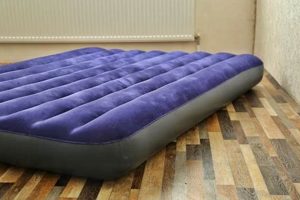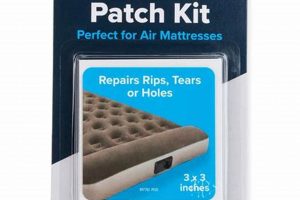The persistent loss of air within an inflatable sleeping surface is a common predicament. This issue often manifests as a gradual reduction in firmness, necessitating repeated inflation to maintain the desired level of support. For instance, an individual may inflate the mattress fully before sleep, only to awaken to a less supportive and partially deflated surface.
Addressing the cause of this deflation is crucial for ensuring a comfortable and restful sleep. Historically, inflatable mattresses provided a portable and convenient sleeping solution for camping and temporary lodging. However, their reliability depends on maintaining airtight integrity, which directly impacts their usefulness. Identifying and rectifying the source of air leakage enhances the lifespan and overall value of the mattress.
The subsequent sections will explore the typical causes of this issue, focusing on methods for detection and repair. These methods range from simple visual inspections to more involved leak-testing procedures, all aimed at restoring the mattress to its intended function and preventing further air loss.
Addressing Inflatable Mattress Air Loss
The following tips offer practical guidance on identifying and resolving the issue of air leakage in inflatable mattresses. These strategies aim to minimize air loss and extend the useful life of the product.
Tip 1: Conduct a Visual Inspection: Examine the entire surface of the mattress, paying close attention to seams, valves, and any areas that appear stressed or damaged. Look for visible punctures, tears, or abrasions.
Tip 2: Perform a Soapy Water Test: Mix a mild dish soap with water and apply the solution to the mattress surface. Gently press on the mattress and observe for the formation of bubbles, which indicate the presence of an air leak.
Tip 3: Check the Valve Integrity: The valve is a common source of air leakage. Ensure that the valve is properly sealed and tightened. If the valve is removable, inspect it for any signs of damage or debris that may be preventing a complete seal.
Tip 4: Listen for Hissing Sounds: In a quiet environment, carefully listen for the sound of air escaping from the mattress. This can help pinpoint the location of a leak that may be difficult to see.
Tip 5: Utilize a Repair Patch: For small punctures or tears, a repair patch can provide an effective solution. Clean the area around the leak, apply the adhesive patch according to the manufacturer’s instructions, and allow it to cure completely before reinflating the mattress.
Tip 6: Consider Internal Seam Leaks: If external inspection reveals no obvious leaks, the issue may stem from a compromised internal seam. While these are more difficult to repair, specialized adhesives designed for flexible materials may offer a solution.
Tip 7: Regulate Environmental Factors: Extreme temperatures can affect air pressure inside the mattress. Avoid placing the mattress in direct sunlight or areas with significant temperature fluctuations, as this can exacerbate air loss due to expansion and contraction.
Implementing these tips can significantly reduce or eliminate the occurrence of air leakage, leading to improved mattress performance and user satisfaction.
The following section will discuss preventative measures and long-term maintenance strategies to further extend the lifespan of inflatable mattresses.
1. Puncture Identification
The sustained loss of air from an inflatable mattress is frequently attributable to punctures, which compromise the airtight seal essential for maintaining inflation. Accurate and timely identification of these punctures is therefore paramount in addressing the “air mattress keeps deflating” problem.
- Microscopic Perforations
Small punctures, often invisible to the naked eye, can result from abrasion against rough surfaces, pet claws, or minor impacts. These perforations allow a gradual, yet persistent, escape of air, leading to deflation over time. The rate of air loss may be subtle, making detection challenging without employing specific methods such as the soapy water test.
- Gross Punctures and Tears
Larger punctures, caused by sharp objects or excessive stress on the mattress material, are typically more readily apparent. These types of breaches result in a significantly faster rate of deflation and are often accompanied by an audible hissing sound. Identifying these punctures quickly allows for prompt repair and mitigates further air loss.
- Location Specificity
Punctures are more likely to occur in areas of the mattress subject to high stress, such as seams, edges, and the regions directly supporting the user’s weight. Targeted inspection of these areas is essential for efficiently locating the source of the air leak. Understanding the typical puncture locations streamlines the identification process.
- Environmental Factors and Detection Challenges
Ambient conditions can influence the detection of punctures. In noisy environments, the sound of escaping air may be masked. Similarly, subtle punctures may be difficult to identify in poorly lit areas. Effective puncture identification necessitates a quiet environment and adequate lighting to facilitate visual and auditory inspection.
In summary, effective puncture identification is a critical step in resolving the issue of a deflating air mattress. Recognizing the potential for both microscopic and gross punctures, understanding the likely locations, and accounting for environmental challenges are all essential elements of a thorough assessment. Successfully identifying the puncture allows for targeted repair, thereby restoring the mattress to its intended functionality.
2. Valve Integrity
Compromised valve integrity is a primary factor contributing to the continuous deflation observed in air mattresses. The valve serves as the crucial interface for inflation and deflation, and any malfunction directly impacts the mattress’s ability to maintain pressure. A defective valve, whether due to manufacturing flaws, wear and tear, or foreign object obstruction, permits the gradual escape of air, leading to the common complaint of frequent reinflation requirements. For example, a valve seal that has become brittle over time may no longer provide a tight closure, resulting in a slow, undetectable leak. The importance of valve integrity cannot be overstated; it is a foundational component of an air mattress’s functionality.
The implications of a faulty valve extend beyond mere inconvenience. Continuous air loss degrades the user experience, impacting sleep quality and support. Furthermore, repeated reinflation places undue stress on the mattress material, potentially exacerbating existing vulnerabilities or cre
ating new points of failure. Consider the scenario of using an air mattress for camping: a failing valve necessitates carrying a pump and frequently interrupting sleep to restore pressure, defeating the purpose of a convenient sleeping solution. Practical understanding of valve construction and common failure modes allows for informed decision-making in terms of maintenance and replacement.
In summary, the connection between valve integrity and deflation is direct and significant. Maintaining the valve in proper working order is essential for preventing air leakage and ensuring the longevity and usability of the air mattress. Addressing valve-related issues through inspection, cleaning, or replacement presents a practical approach to mitigating the broader problem. A focus on valve integrity is a key element in preventative maintenance and overall air mattress care.
3. Seam Weakness
Seam weakness represents a critical vulnerability in inflatable mattresses, directly contributing to air loss and the resultant deflation issues. These seams, where different sections of the mattress material are joined, are inherently points of potential failure. Any compromise in seam integrity can lead to persistent air leakage, necessitating frequent reinflation and ultimately reducing the mattress’s usability.
- Manufacturing Defects
Manufacturing processes can introduce weaknesses into the seams. Improper welding, insufficient adhesive application, or misalignment of material during the joining process can create points where air can escape. These defects may not be immediately apparent but can progressively worsen with use, leading to gradual deflation. Examples include inconsistent seam width or areas where the adhesive bond is visibly thin or missing.
- Stress and Strain
The seams of an air mattress are subjected to significant stress and strain during inflation, deflation, and use. Body weight distribution concentrates pressure on the seams, particularly along the edges and corners. Over time, this repeated stress can weaken the seam bonds, leading to microscopic tears or separation. The result is a slow but continuous leak, contributing to the overall loss of air.
- Material Degradation
The materials used in air mattress construction are susceptible to degradation from environmental factors such as UV exposure, temperature fluctuations, and humidity. This degradation can compromise the flexibility and strength of the seam adhesives, reducing their ability to maintain a secure bond. As the materials age and become brittle, the seams become more prone to failure under normal use conditions.
- Repair Challenges
Addressing seam weakness presents unique challenges. Unlike punctures that can be easily patched, repairing a compromised seam often requires specialized adhesives and techniques. The internal location of many seams makes access difficult, and attempting a repair may further weaken the surrounding material. In some cases, seam failure may necessitate replacing the entire mattress.
The interplay between manufacturing defects, stress, material degradation, and repair challenges underscores the significance of seam weakness in contributing to deflation problems. Addressing this issue requires a multifaceted approach, including improved manufacturing quality control, careful material selection, and user awareness of factors that can accelerate seam degradation. Recognizing the potential for seam failure is essential for effective maintenance and extending the lifespan of inflatable mattresses.
4. Material Degradation
Material degradation is a significant factor contributing to the issue of air loss in inflatable mattresses. The materials used in their construction are susceptible to various forms of deterioration over time, impacting their ability to maintain an airtight seal and leading to deflation.
- Polymer Breakdown
The primary materials in inflatable mattresses are often polymers, such as PVC or TPU. These polymers can undergo breakdown due to exposure to ultraviolet radiation, ozone, and humidity. This breakdown weakens the material’s structural integrity, making it more prone to punctures, tears, and seam failures. For example, prolonged exposure to sunlight can cause PVC to become brittle and crack, leading to air leaks.
- Plasticizer Migration
Many inflatable mattresses incorporate plasticizers to enhance flexibility and durability. Over time, these plasticizers can migrate out of the material, causing it to become stiff and less pliable. This loss of flexibility increases the risk of cracking and seam separation, facilitating air leakage. The leaching of plasticizers also compromises the material’s ability to conform to pressure, further contributing to deflation.
- Abrasion and Wear
Repeated use of an air mattress results in abrasion and wear on the surface. This wear can thin the material, making it more susceptible to punctures from small objects or pressure points. Microscopic abrasions accumulate over time, gradually weakening the structure and leading to a slow but steady loss of air. The effect is amplified in areas of high contact, such as the center of the mattress.
- Hydrolytic Degradation
Hydrolytic degradation occurs when the mattress material reacts with moisture, causing it to break down chemically. This process is accelerated in humid environments and can affect both the polymer structure and the adhesive used in seams. Hydrolysis weakens the material’s resistance to pressure and tension, increasing the likelihood of leaks and seam failures. Properly storing the mattress in a dry environment can mitigate this type of degradation.
The cumulative effects of polymer breakdown, plasticizer migration, abrasion, and hydrolytic degradation directly impact the longevity and performance of inflatable mattresses. Addressing material degradation through careful storage practices, UV protection, and selecting mattresses constructed from more durable materials can help mitigate the issue of “air mattress keeps deflating” and extend the lifespan of the product.
5. Temperature Influence
Temperature significantly influences the air pressure within inflatable mattresses, thereby directly impacting their ability to maintain inflation. According to the ideal gas law, pressure is directly proportional to temperature when volume is held constant. As ambient temperature increases, the air inside the mattress expands, leading to a rise in internal pressure. Conversely, a decrease in temperature results in a pressure reduction. The observed phenomenon where an inflatable mattress loses firmness overnight can often be attributed to a drop in temperature as the surrounding environment cools.
The importance of understanding temperature’s role is underscored by real-world usage scenarios. Consider an air mattress used for camping: during the day, exposure to direct sunlight and warmer air temperatures can cause the mattress to over-inflate, potentially stressing seams or even leading to rupture. Conversely, as nighttime
temperatures plummet, the reduced pressure may create the sensation of a deflated mattress, necessitating re-inflation. This understanding allows users to anticipate pressure fluctuations and proactively adjust inflation levels to prevent damage or discomfort. Careful consideration of these dynamics is crucial for optimal performance.
In summary, temperature fluctuations exert a direct influence on air mattress pressure and perceived inflation levels. Recognizing this relationship enables proactive management of inflation to mitigate the effects of temperature changes, ensuring both comfort and longevity of the mattress. While material properties and structural integrity are vital, accounting for temperature’s impact represents a fundamental aspect of responsible air mattress maintenance and usage.
Frequently Asked Questions
The following addresses common inquiries regarding the persistent loss of air in inflatable mattresses, providing factual information to assist in troubleshooting and maintenance.
Question 1: What are the most common causes of air mattress deflation?
The most frequent causes include punctures (often microscopic), valve malfunction, seam weakness, material degradation due to age or environmental factors, and changes in ambient temperature.
Question 2: How can a microscopic puncture be located?
A solution of mild soap and water applied to the inflated mattress surface will reveal small punctures. Bubbles will form at the point of air leakage. Careful observation is required.
Question 3: Is it possible to repair a leak in a seam?
Seam repairs are generally more challenging than puncture repairs. Specialized adhesives designed for flexible materials may provide a temporary solution. However, seam repairs often require expert assistance or mattress replacement.
Question 4: How does temperature affect air mattress pressure?
Air pressure within the mattress is directly proportional to temperature. A decrease in temperature will reduce the air pressure, potentially resulting in a perceived loss of inflation. Conversely, increased temperature can increase pressure.
Question 5: What preventative measures can extend the lifespan of an air mattress?
Proper storage in a cool, dry environment, avoiding over-inflation, and protecting the mattress from sharp objects will extend its lifespan. Regular inspections for wear and tear are also recommended.
Question 6: How often should an air mattress be inspected for leaks?
Regular inspections, ideally before each use, are recommended to identify potential leaks early. This proactive approach minimizes air loss and prevents further damage.
Addressing air mattress deflation requires a methodical approach, encompassing inspection, diagnosis, and appropriate repair or preventative measures.
The next section will discuss advanced troubleshooting techniques for persistent deflation issues.
Addressing Persistent Inflatable Mattress Deflation
The preceding analysis has detailed the multifactorial nature of inflatable mattress deflation. From microscopic punctures to valve failures, seam weaknesses, and material degradation exacerbated by environmental factors, the root causes are diverse and often interconnected. Effective mitigation requires a comprehensive approach encompassing proactive inspection, meticulous repair techniques, and informed preventative measures.
Consistent application of the outlined diagnostic and remedial strategies is essential to maximizing the lifespan and usability of inflatable mattresses. The issue of air loss warrants diligent attention, ensuring both user comfort and the sustainable use of these portable sleeping solutions. Future advancements in material science and manufacturing processes may offer enhanced resistance to deflation, but for now, informed user practices remain paramount.


![Best Puncture Resistant Air Mattress [Guide] Comfort Now! Organic & Natural Mattress Buyer’s Guide: Non-Toxic Sleep Solutions Best Puncture Resistant Air Mattress [Guide] Comfort Now! | Organic & Natural Mattress Buyer’s Guide: Non-Toxic Sleep Solutions](https://mattressworldpa.com/wp-content/uploads/2025/07/th-6547-300x200.jpg)




